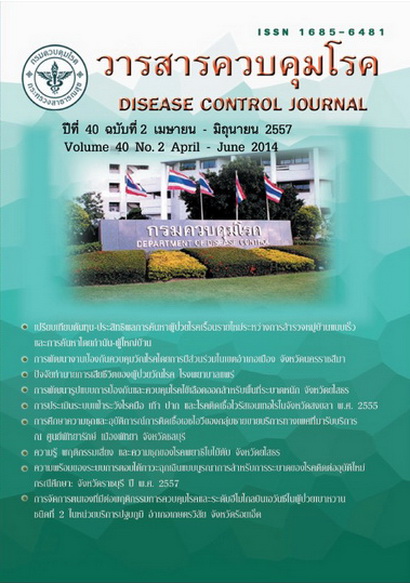Model development of Dengue fever prevention and control for highly epidemic area in Yasothorn Province
DOI:
https://doi.org/10.14456/dcj.2014.20Keywords:
model development, DHF prevention and controlAbstract
This study aimed to develop the model of Dengue Hemorrhagic fever (DHF) prevention and control for highly epidemic area in Yasothon Province during June-December,2013. The study design is composed of the qualitative study and experimental study. The focus group was performed for collect data on the former DHF control measure in the community before intervention. For the experimental study, Tambon Srikeaw was assigned as the study area and the adjacent Tambon, namely Samakki, as control area. The study area was implemented by intervention with building people participation, setting up social measures, mobilizing social measures into public policies, implementing reinforcement measures, encouraging community innovations and enhancing people to follow the social measures continuously. While in the control area, the implementation was done following the usual plan. Data collection such as interview with questionnaire, mosquito larva survey and entomological study, was carried out at before and after intervention in both areas. The data analysis was conducted by using descriptive statistics and inference statistics and content analysis. The results revealed that: at baseline, both the study area and control area had DHF epidemic with rate of 604.73 per 100,000 population and people's behavior and community risk on DHF prevention and control at similar level. In the study area, the average score of knowledge, practice on DHF prevention and control of family members and community participation after intervention higher than before significantly at level of 0.05, otherwise, mosquito larva index and mosquito density after intervention were reduced significantly, comparing with before intervention. The control area the average score of knowledge, practice on DHF prevention and control of family members and community participation, mosquito larva index and mosquito density before and after intervention was not significantly different at level of 0.05. Following the result of this study , the recommendation on public health policy was the Ministry of Public Health should mobilizing social measures as public policies and building all network participation to implement DHF prevention and control measure in highly epidemic periods and recommendation for practice was in highly epidemic areas, building people participation and setting up social measures should be emphasized for surveillance and proper DHF prevention and control measure in various communities.
Downloads
References
2. สำนักงานสาธารณสุขจังหวัดยโสธร. รายงานสถานการณ์การระบาดของโรคไข้เลือดออก ปี 2552-2555 สรุปผลการดำเนินงานโรคติดต่อ ปี 2555. ยโสธร: กลุ่มงานควบคุมโรคติดต่อ สำนักงานสาธารณสุขจังหวัดยโสธร; 2555.
3. สำนักงานสาธารณสุขจังหวัดยโสธร. รายงานสถานการณ์โรคไข้เลือดออก จังหวัดยโสธร ปี 2556. ยโสธร: กลุ่มงานควบคุมโรคติดต่อ สำนักงานสาธารณสุขจังหวัดยโสธร; 2556.
4. Cohen, J.M. and uphoff, N.T. Rural development participation: concept and measures for project design implementation and evaluation. Rural Development Committee Center for International Studies, New York: Cornell University Press; 1981.
5. อมร นนทสุต. “แผนที่ทางเดินยุทธศาสตร์-ก้าวใหม่ ของการบริหารจัดการสุขภาพ” [อินเทอร์เน็ต]. [สืบค้นเมื่อ 12 พ.ค. 2555]. แหล่งข้อมูล: http://www.ipisear.org/ srm/files/53080 l_srm_ health_mge.pdf
6. Anderson, James E. Public policy-making: introduction. 2 nd. New York: Houghton Mifflin Company; 1994.
7. World Health Organization. WHO report: Global strategy for Dengue prevention and control 2012-2020. Geneva: World Health Organization; 2012.
8. Phuanukoonon S. Effective of Dengue control practices in household water containers in North¬east Thailand. Tropical Medical and International Health 2005;10:755-63.
Downloads
Published
How to Cite
Issue
Section
License
Articles published in the Disease Control Journal are considered as academic work, research or analysis of the personal opinion of the authors, not the opinion of the Thailand Department of Disease Control or editorial team. The authors must be responsible for their articles.






